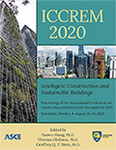International Conference on Construction and Real Estate Management 2020
Research on Ultra-Low Power Energy-Saving Green Buildings Pluripotent Complementary Measures
Publication: ICCREM 2020: Intelligent Construction and Sustainable Buildings
ABSTRACT
The ultra-low-energy green building, as the development direction of the future building, has greatly changed the current construction industry structure, and has been highly concerned and rapidly promoted by local governments. By analyzing the current problems of energy consumption of green buildings; taking the cold region as an example, using eQUEST to simulate the building energy consumption, it is determined that the energy-saving effect of ultra-low-energy buildings is obvious. In order to ensure the smooth implementation of energy-saving targets for ultra-low-energy green buildings, the energy supply of multi-energy complementary ultra-low-energy buildings and the design and construction of key technical measures are introduced; to ensure energy-saving and consumption reduction for multi-energy complementary green buildings. The fundamental purpose is to establish a monitoring system for ultra-low energy buildings. The construction energy conservation and consumption reduction work will gradually shift from the measure orientation to the effect orientation, and the data will be used to illustrate the substantial content of building energy conservation and consumption reduction.
Get full access to this article
View all available purchase options and get full access to this chapter.
REFERENCES
Agostino, D. (2015). “Assessment of the progress towards the establishment of definitions of Nearly Zero Energy Buildings (NZEBs) in European Member States.” Journal of Building Engineering, 1(2), 20-32.
Feist, W., Schnieders, J., Dorer, V. and Haas, A. (2005). “Re-inventing air heating: Convenient and comfortable within the frame of the Passive House concept.” Energy and Buildings, 37(11), 1186-1203.
Kalamees, T. (2007). “Air tightness and air leakages of new lightweight single-family detached houses in Estonia.” Building and environment, 42(6), 2369-2377.
Li, D., Yang, L. and Lam, J.C. (2013).“Zero energy buildings and sustainable development implications-A review.” Energy, 54(1), 1-10.
Li, H., Xu, W., Yu, Z., Wu, J. and Yu, Z. (2018). “Discussion of a combined solar thermal and ground source heat pumpsystem operation strategy for office heating.” Energy and Buildings, 162(1), 42-53.
Nguyen, A.T., Reiter, S. and Rigo, P. (2014). “A review on simulation-based optimization methods applied to building performance analysis.” Applied Energy, 113(2), 1043-1058.
Pons, O. (2014). “Assessing the sustainability of prefabricated buildings.” Eco-efficient Construction and Building Materials, 434-456.
Roaf, S., Brotas, L. and Nicol, F. (2015). “Counting the costs of comfort.” Building Research Information, 43(3), 269-273.
Schnieders, J., Feist, W. and Rongen, L. (2015). “Passive Houses for different climate zones.” Energy and Buildings, 105(2), 71-87.
Song, L. and Zhou, X. (2017). “Simulation study on heating behavior and energy consumption of heat pump air conditioners for residents in Shanghai.” HVAC, 47(09), 55-60. (in Chinese).
Thalfeldt, M., Pikas, E., Kurnitski, J. and Voll, H. (2013). “Facade design principles for nearly zero energy buildings in a cold climate.” Energy and Buildings, 67(3), 309-321.
Wang, J., Yan, D. and Lin, L. (2014). “The applicability of high performance envelope building in China.” Heating Ventilating Air Conditioning, 44(1), 302-307. (in Chinese).
Xu, W., Li, H. and Yu, Z. (2017). “Technology and performance of China academy of building research nearly zero energy building.” Zero Carbon Building Jouranl, 5(1), 29-40.
Younes, C., Shdid, C.A. and Bitsuamlak, G. (2012). “Air infiltration through building envelopes: A review.” Journal of Building physics, 35(3), 267-302.
Yu, J., Yang, C., Tian, L. and Liao, D. (2009). “A study on optimum insulation thicknesses of external walls in hot summer and cold winter zone of China.” Applied Energy, 86(11), 2520-2529.
Information & Authors
Information
Published In
ICCREM 2020: Intelligent Construction and Sustainable Buildings
Pages: 238 - 248
Editors: Yaowu Wang, Ph.D., Harbin Institute of Technology, Thomas Olofsson, Ph.D., Luleå University of Technology, and Geoffrey Q. P. Shen, Ph.D., Hong Kong Polytechnic University
ISBN (Online): 978-0-7844-8323-7
Copyright
© 2020 American Society of Civil Engineers.
History
Published online: Oct 14, 2020
Authors
Metrics & Citations
Metrics
Citations
Download citation
If you have the appropriate software installed, you can download article citation data to the citation manager of your choice. Simply select your manager software from the list below and click Download.
